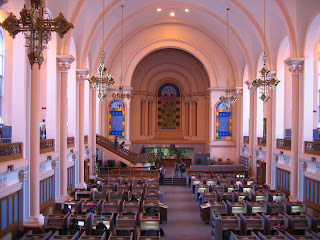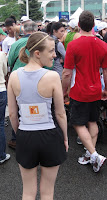This article was originally written in early 2009 but never published.
As history professor Gary Evans remarks at the beginning of his book,
Landmark of learning: a chronicle of the Dawson College building and site, Montreal has always had a tradition of love of, and dedication to, education. This commitment was largely established by religious orders in the New World during the early days of European exploration. Montreal’s first school, established in 1658, was housed in a converted stable on the site of the current Montreal City Hall, and was formally organized from some classes taught by a young Roman Catholic nun named
Marguerite Bourgeoys. The school was operated by the nuns of Marguerite Bourgeoys’ religious order, which, within a year, became known as the
Congrégation de Notre Dame (CND). Over the centuries, the commitment of the CND’s sisters to education expanded, and includes, in the present day, a private, pre-university college (termed CEGEP in Quebec) known as
Marianopolis College.
Marianopolis is nestled on a hill in Westmount, on the island of Montreal, and holds classes for its 1800 students
in the former Mother House of the Congrégation de Notre Dame. On the other side of Westmount, also located in a former CND Mother House and co-existing peacefully with its neighbour to the north, is
Dawson College, the largest public CEGEP in the province serving over 10,000 students. In the interests of full disclosure, and for those of you who don't know this, I am a Marianopolis alumnus. My two years there, living with two CND nuns, Sister Morrissey and Sister Boisvert (and my beloved
rezlings!), and attending the
Liberal Arts program, are among the happiest and most creatively rich years of my life (so far).
More interestingly, on either edge of the Montreal Island city of Westmount, a unique situation now exists: two college libraries, at Marianopolis and Dawson Colleges, are now housed in former CND chapels.
"I have always imagined that Paradise will be a kind of library," Jorge Luis Borges mused in his "Poem of the gifts." Many certainly would consider a library a kind of earthly paradise: a place of learning, a home for all transcribed knowledge, an eternal, sacred space for the wisdom of all ages. Nancy Kalikow Maxwell observed much the same thing in her May 2006 article for
American Libraries, underlining that "libraries evoke a feeling of goodness, power, and lasting importance that resembles that experienced in an old-fashioned church. An ineffable force seems present within the walls." Libraries "fulfill purposes that no amount of automation will ever accomplish. Libraries control the chaos of information, bestow immortality, transmit culture through stories, promote community, and provide secular, sacred space. In filling these eternal roles, librarians hold a sacred profession. Though we work in a secular setting, librarianship is a spiritual vocation."
In the cases of the Marianopolis and Dawson College libraries, these statements are perhaps more true than ever.

There is certainly an "ineffable force" present within the walls of the
Marianopolis College Library, at left. The current site of this English-language college, at 4873 Westmount Ave., was built in 1926 to house the Collège Marguerite-Bourgeoys/Marguerite Bourgeoys College. Former Coordinator of Library Services at Marianopolis, Judith Stonehewer, explains that the chapel where the library is now located was built in 1950—ironically, as a library for the students of the then-French side of the College. In 1985, Stonehewer adds, the building became the Mother House for the sisters of the CND, and the library was converted into a chapel for them (the former altar is where you can see periodicals in the above image). The space above the circulation desk, which is currently a study loft for students, then housed one of the famed
Casavant organs, Stonehewer reports, and "the lofts above the former altar area were rooms that the sisters used for tending their plants."

In August 2007, Marianopolis College moved into the CND Mother House in upper Westmount, and the library moved into the chapel space. Extensive preparations were needed to accommodate the collections in this new space. Current Coordinator of Library Services, Amy MacLean, led a massive weeding project in 2006, involving four student employees as well as library staff. The library is now settled into its new space, which includes the chapel (housing circulation, reference, and periodicals, with the walls lined by study carrels), the lofts, and the floor below the chapel where many of the library's print collections are situated. On the main floor, in the chapel, casement windows let light stream into the space, and long rows of low periodical and reference stacks allow visitors' eyes to roam far down what was once the chapel's nave up to the altar. On either side of the altar are small study nooks, closed off from the altar by decorated iron gates. Gleaming marble stairs lead students from the main chapel floor downstairs into row upon row of stacks, each framing a narrow window looking out onto the College grounds and an interior courtyard.

Meanwhile, at the bottom of the Westmount hill, Dawson College's majestic chapel is still "the centre point of the interior" of the college complex, as described by Gary Evans in
Landmark of learning, and as was intended when it was completed in 1908. The chapel, where the mortal remains of Marguerite Bourgeoys once lay, was also home to another magnificent Casavant organ (at right). In 1982, Dawson College bid to purchase the complex from the sisters of the CND, whose population was dwindling. Extensive renovations and repairs were planned, complicated by the historic nature of the building. A discussion soon ensued regarding what new role the chapel could play in the College. As Evans pondered, should it be "a theatre, a cafeteria, a student meeting place, or a library?" Until then, the College library had collections located at three different Dawson campuses. Once it was determined that the chapel would house the
College library, a large moving project was undertaken, which required the integration of three different call number ranges! When I met with Carolyn Gilmore, the library's coordinator, she showed me pictures of the various boxes, labelled according to the originating campus and the row number, as well as her many pages of notes regarding each section of the new library. The movers, and the library staff of 26, moved and unpacked the boxes in the new library, and shelved the materials (integrating the three collections) during a heat wave in August 1988.
There were, of course, several "quirks" to the Dawson chapel space. Numerous alterations had to be made to ensure that the chapel complied with the fire codes, and a staircase was built linking the main floor with the mezzanine. One set of stacks on the 6th floor ended up being too tall for the new ceiling that had been lowered 6 inches, and had to be cut down to fit. The altar rail had to be cut, and was apparently quite the puzzle to put back together. On the eve of Dawson's official opening, Gilmore realized that, with no security system or locks for the 13 doors leading into and out of the library on both floors, the library couldn’t open its doors! The college opened as scheduled, but it was a month before the Director General was able to station security guards at each door until proper locks could be installed.
Less than a year after opening, a pipe that was accidentally not closed when the engineers started up the air-conditioning system in the spring leaked, causing a flood that damaged the library’s holdings (the pipe was located above the library’s reference collection) and left Gilmore wading in ankle-deep water. Unfazed, she recalled an article she had seen regarding a flood at one of the Dalhousie University libraries, and she contacted a librarian there who explained the process to follow to save as many books as possible. She contacted and engaged a company in Montreal that freeze-dried damaged library books. Gilmore remembers that the workers “jammed (the damaged books) into the study carrels” and ran de-humidifiers for nearly a week. Luckily some duplicate copies of the damaged books that were located at other campuses could also be called in to replace unsalvageable items.

Despite this rocky beginning, the Dawson library is now a peaceful sanctuary within the college. With the exception of two OPACs, the computers are mainly housed one floor above the chapel, on the 6th floor (originally the infirmary). The space feels muted, airy and full, again, of that "ineffable force." Seven works of art by Quebec artists grace the spaces on the walls in the chapel where religious works of art once hung. Since Gilmore was informed by a sound engineer that there is a 7-second echo in the chapel, there is no metal (except for chair legs) in the chapel space. Study carrels were custom-made from wood, with extra sound panels added to muffle any noise. There are additional sound panels (in blue, in keeping with the original mock-up for the chapel discovered during renovations - they can be seen in the photo at left) on the lower walls of the chapel, as well as extra thick under carpeting. I asked Gilmore whether any of the sisters have re-visited the space since its transformation, and what they thought of it. She told me that groups of CND nuns re-visit the College every autumn, and they love that it is once again an educational institution.
In some ways, the story of Marguerite Bourgeoys’s attempts to educate the children of the New World has come full circle. Two buildings that once housed the religious order she founded are now significant educational institutions, and one of these—Marianopolis—is still directed by a member of her order. Librarians continue to support the educational goals of those 17th century nuns who fulfilled their own vocations in spaces designed for a different, but not so different, purpose.
Bibliography:
Evans, Gary.
Landmark of learning: a chronicle of the Dawson College building and site. Westmount, Quebec: Dawson College, 1992.
Gilmore, Carolyn. Interview with Alexandra Yarrow. 16 February 2009.
Lanthier, Helen. "A page from our history." Alma Matters Fall/Winter 2007: 12.
MacLean, Amy. "News from the Library."
Alma Matters Fall/Winter 2006: 1.
Maxwell, Nancy Kalikow. "Sacred Stacks."
American Libraries 3.5 (May 2006): 36-37.
"Montreal's first school celebrates 350 years." Westmount Examiner. 24 October 2008. 18 February 2009. Stonehewer, Judith. "RE: Marianopolis library history." E-mail to Alexandra Yarrow. 17 February 2009.









